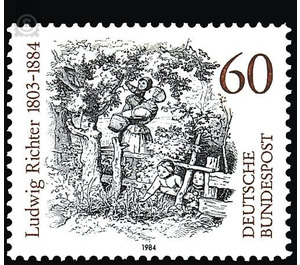100th anniversary of death from Ludwig Richter - Germany / Federal Republic of Germany 1984 - 60 Pfennig
Theme: Art & Culture
| Country | Germany / Federal Republic of Germany |
| Issue Date | 1984 |
| Face Value | 60.00 |
| Color | black white |
| Perforation | K 14:13 3/4 |
| Printing Type | 2-color Typography |
| Stamp Type | Postage stamp |
| Item Type | Stamp |
| Chronological Issue Number | 1086 |
| Chronological Chapter | GER-BRD |
| SID | 851117 |
| In 47 Wishlists | |
The idea to commemorate the painter and illustrator Ludwig Richter (1803-1884) on his 100th anniversary with a stamp seems to be obvious. There is not a single German artist whose works have been reproduced more frequently since their appearance than the Ludwig Richter. The most varied compositions from his work reached easily and in a few years runs of over 100,000 copies. For a good 100 years he was the epitome of the popular German artist - and yet he is not really anchored in the consciousness of the present. Why is that? If Richter's characterizations from the countless publications are combined with his or her works, then one not only realizes that they are also about 100 years as good as identical, but that today, when reading them, a pronounced discomfort creeps up. To quote only a few: "Rarely has a German painter's manner and custom been so pure and unadulterated in a German painter than in Ludwig Richter," "as long as German meaning and spirit exist, Ludwig Richter will continue to live among the German people" German people will cling to their own, and German style and customs will never perish. " Publications are called, for example, "Ludwig Richter, Heimat und Volk," and his merit is said to be "based on his power to open up to a great extent the spiritual natural sources of our nationality through the pictorial imagination." Now, the Ludwig Richter reception has not reached its peak in the Third Reich - for that time, his art was ultimately too unheroic - but in the 1870s and especially after the First World War. Especially after the First World War, his art had expressed solace. It was meant to see all that the war had destroyed once and for all: naïve childlike happiness, pure, unadulterated faith, rural, quiet, Sunday life, goodness and pure feeling in a self-contained, diligent world to which that was Evil not approached. 1919 appears an issue on emergency paper with a start edition of 80.000! Ludwig Richter has been primarily designer of the woodcut, more than 3,000 sheets have been cut after him. He belongs to the revival of this technique in the 19th century, which was regarded as typical German since Dürer. In spite of certain technical innovations, in the nineteenth century it is consciously outmoded in appearance, even giving the impression of the premature, the past, with which the good old days were associated, when one was still content and in harmony with nature. This shows a late-romantic trait, which the new era dislikes with the "hisses, roars and whistles of the locomotive" (Richter). Richter designs the ideal world as a bourgeois dream that compensates for the cold rationalism of the dismembered, fashionable present, according to Richter himself. But what has been said can not completely explain the enormous success of Richter, two things are added. On the one hand, his themes are fond of fairy tales and legends and of the small-town rural environment. None of his characters, as far as the dwarfish proportions are concerned, pretend to be real. The fairy-tale characters are slightly poetically transfigured, his urban Philistines seen in mild irony. On the other hand - and this is also the basis for the stamp of the stamp - his works are artistically completely composed in their genre, intention and representation permeate each other. The characters and nature are close to us, closer than they can be. The image of the rural world is narrow and complete, but rounded in form, at rest and cheerful. And in this respect, Ludwig Richter is really unsurpassed, but also unrepeatable. (Text: Prof. Dr. Werner Busch, Kunsthistorisches Institut der Universität Bochum)


